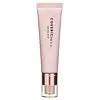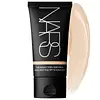Banila Co Covericious Skin Fit Tinted Moisturizer SPF 40 PA++ Versus NARS Cosmetics Pure Radiant Tinted Moisturizer SPF 30
What's inside
What's inside
 Key Ingredients
Key Ingredients

 Benefits
Benefits

 Concerns
Concerns

 Ingredients Side-by-side
Ingredients Side-by-side

Water
Skin ConditioningCyclopentasiloxane
EmollientCI 77891
Cosmetic ColorantGlycerin
HumectantDipropylene Glycol
HumectantIsohexadecane
EmollientPolymethylsilsesquioxane
Butylene Glycol Dicaprylate/Dicaprate
EmollientAlcohol Denat.
AntimicrobialButyloctyl Salicylate
Skin ConditioningNiacinamide
SmoothingPentylene Glycol
Skin ConditioningMica
Cosmetic ColorantPEG/PPG-19/19 Dimethicone
EmulsifyingCetyl PEG/PPG-10/1 Dimethicone
EmulsifyingMagnesium Sulfate
Dicaprylyl Carbonate
EmollientGlyceryl Behenate/Eicosadioate
EmollientCI 77492
Cosmetic ColorantStearic Acid
CleansingAlumina
AbrasiveCaprylyl Glycol
EmollientGlyceryl Caprylate
EmollientCI 77491
Cosmetic ColorantSodium Hyaluronate
HumectantSilica Dimethyl Silylate
EmollientTriethoxycaprylylsilane
Aluminum Hydroxide
EmollientIsododecane
EmollientOctyldodecanol
EmollientPEG-9 Polydimethylsiloxyethyl Dimethicone
EmulsifyingParfum
MaskingAdenosine
Skin ConditioningTrisodium Ethylenediamine Disuccinate
Polypropylsilsesquioxane
CI 77499
Cosmetic ColorantPolyglyceryl-4 Isostearate
EmulsifyingIsopropyl Titanium Triisostearate
EmollientTocopherol
AntioxidantLinolenic Acid
CleansingAsiaticoside
AntioxidantAsiatic Acid
Skin ConditioningMadecassic Acid
Skin ConditioningButylene Glycol
HumectantCentella Asiatica Leaf Extract
Skin Conditioning1,2-Hexanediol
Skin ConditioningCentella Asiatica Extract
CleansingWater, Cyclopentasiloxane, CI 77891, Glycerin, Dipropylene Glycol, Isohexadecane, Polymethylsilsesquioxane, Butylene Glycol Dicaprylate/Dicaprate, Alcohol Denat., Butyloctyl Salicylate, Niacinamide, Pentylene Glycol, Mica, PEG/PPG-19/19 Dimethicone, Cetyl PEG/PPG-10/1 Dimethicone, Magnesium Sulfate, Dicaprylyl Carbonate, Glyceryl Behenate/Eicosadioate, CI 77492, Stearic Acid, Alumina, Caprylyl Glycol, Glyceryl Caprylate, CI 77491, Sodium Hyaluronate, Silica Dimethyl Silylate, Triethoxycaprylylsilane, Aluminum Hydroxide, Isododecane, Octyldodecanol, PEG-9 Polydimethylsiloxyethyl Dimethicone, Parfum, Adenosine, Trisodium Ethylenediamine Disuccinate, Polypropylsilsesquioxane, CI 77499, Polyglyceryl-4 Isostearate, Isopropyl Titanium Triisostearate, Tocopherol, Linolenic Acid, Asiaticoside, Asiatic Acid, Madecassic Acid, Butylene Glycol, Centella Asiatica Leaf Extract, 1,2-Hexanediol, Centella Asiatica Extract
Water
Skin ConditioningDimethicone
EmollientEthylhexyl Methoxycinnamate
UV AbsorberTitanium Dioxide
Cosmetic ColorantButylene Glycol
HumectantPropanediol
SolventDiethylhexyl Succinate
EmollientGlycerin
HumectantNylon-12
Cyclomethicone
EmollientPEG-9 Polydimethylsiloxyethyl Dimethicone
EmulsifyingPEG-10 Dimethicone
Skin ConditioningAluminum Hydroxide
EmollientDiphenylsiloxy Phenyl Trimethicone
Skin ConditioningDisteardimonium Hectorite
StabilisingSorbitan Sesquiisostearate
EmulsifyingStearic Acid
CleansingPhenoxyethanol
PreservativePolymethylsilsesquioxane
Parfum
MaskingDimethicone/Vinyl Dimethicone Crosspolymer
Skin ConditioningTrisodium EDTA
Aluminum Distearate
Emulsion StabilisingTalc
AbrasiveAscorbyl Glucoside
AntioxidantPolysilicone-2
Vibrio Alginolyticus Ferment Filtrate
AbrasiveTocopherol
AntioxidantAlteromonas Ferment Filtrate
HumectantMaris Sal
Skin ConditioningHydrogen Dimethicone
BHT
AntioxidantAlgae
Skin ConditioningSodium Metabisulfite
AntioxidantCurcuma Longa Root Extract
MaskingPotassium Sorbate
PreservativeGeraniol
PerfumingLimonene
PerfumingCitral
PerfumingLinalool
PerfumingCI 77891
Cosmetic ColorantCI 77491
Cosmetic ColorantCI 77492
Cosmetic ColorantCI 77499
Cosmetic ColorantWater, Dimethicone, Ethylhexyl Methoxycinnamate, Titanium Dioxide, Butylene Glycol, Propanediol, Diethylhexyl Succinate, Glycerin, Nylon-12, Cyclomethicone, PEG-9 Polydimethylsiloxyethyl Dimethicone, PEG-10 Dimethicone, Aluminum Hydroxide, Diphenylsiloxy Phenyl Trimethicone, Disteardimonium Hectorite, Sorbitan Sesquiisostearate, Stearic Acid, Phenoxyethanol, Polymethylsilsesquioxane, Parfum, Dimethicone/Vinyl Dimethicone Crosspolymer, Trisodium EDTA, Aluminum Distearate, Talc, Ascorbyl Glucoside, Polysilicone-2, Vibrio Alginolyticus Ferment Filtrate, Tocopherol, Alteromonas Ferment Filtrate, Maris Sal, Hydrogen Dimethicone, BHT, Algae, Sodium Metabisulfite, Curcuma Longa Root Extract, Potassium Sorbate, Geraniol, Limonene, Citral, Linalool, CI 77891, CI 77491, CI 77492, CI 77499
 Reviews
Reviews

Ingredients Explained
These ingredients are found in both products.
Ingredients higher up in an ingredient list are typically present in a larger amount.
Aluminum Hydroxide is a form of aluminum. It can be naturally found in nature as the mineral gibbsite. In cosmetics, Aluminum Hydroxide is used as a colorant, pH adjuster, and absorbent.
As a colorant, Aluminum Hydroxide may add opacity, or reduce the transparency. Aluminum hydroxide is contains both basic and acidic properties.
According to manufacturers, this ingredient is an emollient and humectant. This means it helps hydrate the skin.
In medicine, this ingredient is used to help relieve heartburn and help heal ulcers.
There is currently no credible scientific evidence linking aluminum hydroxide in cosmetics to increased cancer risk.
Major health organizations allow the use of aluminum hydroxide in personal care products and have not flagged it as a carcinogenic risk at typical usage levels.
Learn more about Aluminum HydroxideButylene Glycol (or BG) is used within cosmetic products for a few different reasons:
Overall, Butylene Glycol is a safe and well-rounded ingredient that works well with other ingredients.
Though this ingredient works well with most skin types, some people with sensitive skin may experience a reaction such as allergic rashes, closed comedones, or itchiness.
Learn more about Butylene GlycolCi 77491 is also hydrated iron III oxide. It's sole purpose is to give a red/pink hue to products.
Iron III oxides are classified as inorganic chemicals for coloring.
Synthetically created Ci 77491 is considered safer than those naturally found. This is because the synthetically created version may contain less impurities. Iron oxides are generally non-toxic and non-allergenic.
Learn more about CI 77491Ci 77492 is also hydrated iron III oxide. It's sole purpose is to give a yellow hue to products.
Iron III oxides are classified as inorganic chemicals for coloring.
Synthetically created Ci 77492 is considered safer than those naturally found. This is because the synthetically created version may contain less impurities. Iron oxides are generally non-toxic and non-allergenic.
Learn more about CI 77492Ci 77499 is also hydrated iron III oxide. It is created from mixing red and black iron oxides. This helps give shades of darkness to a product.
Iron III oxides are classified as inorganic chemicals for coloring.
Ci 77891 is a white pigment from Titanium dioxide. It is naturally found in minerals such as rutile and ilmenite.
It's main function is to add a white color to cosmetics. It can also be mixed with other colors to create different shades.
Ci 77891 is commonly found in sunscreens due to its ability to block UV rays.
Learn more about CI 77891Glycerin is already naturally found in your skin. It helps moisturize and protect your skin.
A study from 2016 found glycerin to be more effective as a humectant than AHAs and hyaluronic acid.
As a humectant, it helps the skin stay hydrated by pulling moisture to your skin. The low molecular weight of glycerin allows it to pull moisture into the deeper layers of your skin.
Hydrated skin improves your skin barrier; Your skin barrier helps protect against irritants and bacteria.
Glycerin has also been found to have antimicrobial and antiviral properties. Due to these properties, glycerin is often used in wound and burn treatments.
In cosmetics, glycerin is usually derived from plants such as soybean or palm. However, it can also be sourced from animals, such as tallow or animal fat.
This ingredient is organic, colorless, odorless, and non-toxic.
Glycerin is the name for this ingredient in American English. British English uses Glycerol/Glycerine.
Learn more about GlycerinParfum is a catch-all term for an ingredient or more that is used to give a scent to products.
Also called "fragrance", this ingredient can be a blend of hundreds of chemicals or plant oils. This means every product with "fragrance" or "parfum" in the ingredients list is a different mixture.
For instance, Habanolide is a proprietary trade name for a specific aroma chemical. When used as a fragrance ingredient in cosmetics, most aroma chemicals fall under the broad labeling category of “FRAGRANCE” or “PARFUM” according to EU and US regulations.
The term 'parfum' or 'fragrance' is not regulated in many countries. In many cases, it is up to the brand to define this term.
For instance, many brands choose to label themselves as "fragrance-free" because they are not using synthetic fragrances. However, their products may still contain ingredients such as essential oils that are considered a fragrance by INCI standards.
One example is Calendula flower extract. Calendula is an essential oil that still imparts a scent or 'fragrance'.
Depending on the blend, the ingredients in the mixture can cause allergies and sensitivities on the skin. Some ingredients that are known EU allergens include linalool and citronellol.
Parfum can also be used to mask or cover an unpleasant scent.
The bottom line is: not all fragrances/parfum/ingredients are created equally. If you are worried about fragrances, we recommend taking a closer look at an ingredient. And of course, we always recommend speaking with a professional.
Learn more about ParfumPEG-9 Polydimethylsiloxyethyl Dimethicone is a type of silicone.
Polymethylsilsesquioxane is a silicone used as a film forming agent.
When applied to the skin, this ingredient creates an invisible film on the surface. This film still allows oxygen to pass through, but prevents moisture from escaping. This can help condition and hydrate the skin. It also leaves a silky feel when applied.
Polymethylsilsesquioxane has not been shown to clog pores. It has been deemed safe to use up to 55%, but most cosmetics use much less.
If you have concerns about using this ingredient, we recommend speaking with a professional.
Learn more about PolymethylsilsesquioxaneStearic Acid is a fatty acid. It is an emollient, emulsifier, and texture enhancer.
As an emollient, stearic acid helps soften skin. It aids the skin's protective barrier by preventing water loss. It also provides a gentle cleansing effect without stripping away natural oils.
Stearic acid may also be used to enhance the texture of products. It can add volume and stabilize ingredients such as water and oil. This can help water and oil ingredients from separating.
Sources of stearic acid include animal or vegetable fats/oils such as coconut or shea. It can be naturally found in butter, cocoa butter, shea butter, vegetable fats, and animal tallow.
This ingredient may not be Malassezia folliculitis, or fungal-acne safe.
Learn more about Stearic AcidTocopherol (also known as Vitamin E) is a common antioxidant used to help protect the skin from free-radicals and strengthen the skin barrier. It's also fat soluble - this means our skin is great at absorbing it.
Vitamin E also helps keep your natural skin lipids healthy. Your lipid skin barrier naturally consists of lipids, ceramides, and fatty acids. Vitamin E offers extra protection for your skin’s lipid barrier, keeping your skin healthy and nourished.
Another benefit is a bit of UV protection. Vitamin E helps reduce the damage caused by UVB rays. (It should not replace your sunscreen). Combining it with Vitamin C can decrease sunburned cells and hyperpigmentation after UV exposure.
You might have noticed Vitamin E + C often paired together. This is because it is great at stabilizing Vitamin C. Using the two together helps increase the effectiveness of both ingredients.
There are often claims that Vitamin E can reduce/prevent scarring, but these claims haven't been confirmed by scientific research.
Learn more about TocopherolWater. It's the most common cosmetic ingredient of all. You'll usually see it at the top of ingredient lists, meaning that it makes up the largest part of the product.
So why is it so popular? Water most often acts as a solvent - this means that it helps dissolve other ingredients into the formulation.
You'll also recognize water as that liquid we all need to stay alive. If you see this, drink a glass of water. Stay hydrated!
Learn more about Water